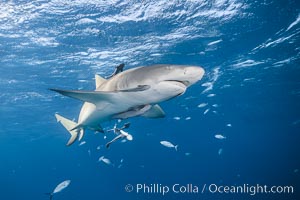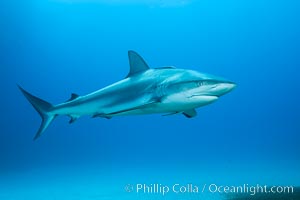
Caribbean reef shark.
Species: Caribbean reef shark, Carcharhinus perezi
Location: Bahamas
Image ID: 31981
Species: Caribbean reef shark, Carcharhinus perezi
Location: Bahamas
Image ID: 31981
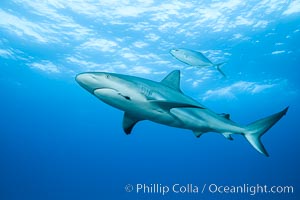
Caribbean reef shark with fishing hook.
Species: Caribbean reef shark, Carcharhinus perezi
Location: Bahamas
Image ID: 31982
Species: Caribbean reef shark, Carcharhinus perezi
Location: Bahamas
Image ID: 31982
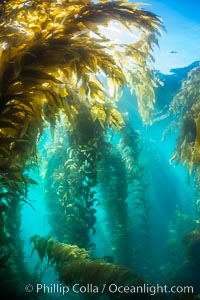
Sunlight streams through giant kelp forest. Giant kelp, the fastest growing plant on Earth, reaches from the rocky reef to the ocean's surface like a submarine forest.
Species: Giant kelp, Macrocystis pyrifera
Location: Catalina Island, California
Image ID: 33434
Species: Giant kelp, Macrocystis pyrifera
Location: Catalina Island, California
Image ID: 33434
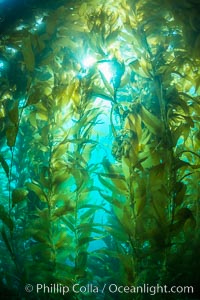
Sunlight streams through giant kelp forest. Giant kelp, the fastest growing plant on Earth, reaches from the rocky reef to the ocean's surface like a submarine forest.
Species: Giant kelp, Macrocystis pyrifera
Location: Catalina Island, California
Image ID: 33435
Species: Giant kelp, Macrocystis pyrifera
Location: Catalina Island, California
Image ID: 33435
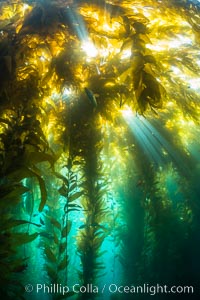
Sunlight streams through giant kelp forest. Giant kelp, the fastest growing plant on Earth, reaches from the rocky reef to the ocean's surface like a submarine forest.
Species: Giant kelp, Macrocystis pyrifera
Location: Catalina Island, California
Image ID: 33436
Species: Giant kelp, Macrocystis pyrifera
Location: Catalina Island, California
Image ID: 33436
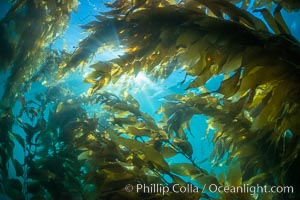
Sunlight streams through giant kelp forest. Giant kelp, the fastest growing plant on Earth, reaches from the rocky reef to the ocean's surface like a submarine forest.
Species: Giant kelp, Macrocystis pyrifera
Location: Catalina Island, California
Image ID: 33437
Species: Giant kelp, Macrocystis pyrifera
Location: Catalina Island, California
Image ID: 33437
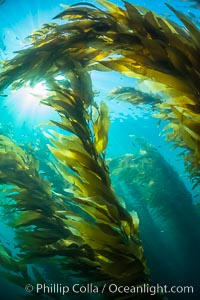
Sunlight streams through giant kelp forest. Giant kelp, the fastest growing plant on Earth, reaches from the rocky reef to the ocean's surface like a submarine forest.
Species: Giant kelp, Macrocystis pyrifera
Location: Catalina Island, California
Image ID: 33438
Species: Giant kelp, Macrocystis pyrifera
Location: Catalina Island, California
Image ID: 33438
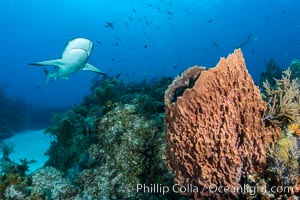
Caribbean reef shark swims over sponges and coral reef.
Species: Caribbean reef shark, Carcharhinus perezi
Location: Bahamas
Image ID: 31979
Species: Caribbean reef shark, Carcharhinus perezi
Location: Bahamas
Image ID: 31979
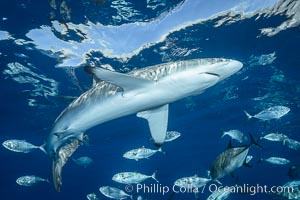
Silky Shark at San Benedicto Islands, Revillagigedos, Mexico.
Species: Silky shark, Carcharhinus falciformis
Location: Socorro Island (Islas Revillagigedos), Baja California, Mexico
Image ID: 33310
Species: Silky shark, Carcharhinus falciformis
Location: Socorro Island (Islas Revillagigedos), Baja California, Mexico
Image ID: 33310
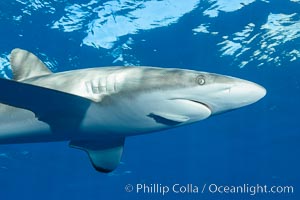
Silky Shark at San Benedicto Islands, Revillagigedos, Mexico.
Species: Silky shark, Carcharhinus falciformis
Location: Socorro Island (Islas Revillagigedos), Baja California, Mexico
Image ID: 33313
Species: Silky shark, Carcharhinus falciformis
Location: Socorro Island (Islas Revillagigedos), Baja California, Mexico
Image ID: 33313
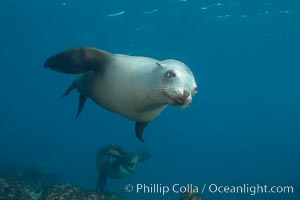
California sea lion, underwater at Santa Barbara Island. Santa Barbara Island, 38 miles off the coast of southern California, is part of the Channel Islands National Marine Sanctuary and Channel Islands National Park. It is home to a large population of sea lions.
Species: California sea lion, Zalophus californianus
Location: Santa Barbara Island, California
Image ID: 23418
Species: California sea lion, Zalophus californianus
Location: Santa Barbara Island, California
Image ID: 23418
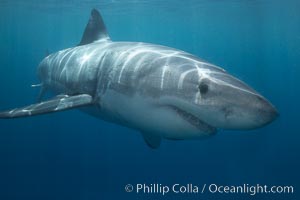
A great white shark swims toward the photographer. Perhaps the shark is considering him as possible prey? The photographer, a "shark diver" is safely situated in a sturdy metal cage. The best location in the world to "shark dive" to view great white sharks is Mexico's Guadalupe Island.
Species: Great white shark, Carcharodon carcharias
Location: Guadalupe Island (Isla Guadalupe), Baja California, Mexico
Image ID: 19457
Species: Great white shark, Carcharodon carcharias
Location: Guadalupe Island (Isla Guadalupe), Baja California, Mexico
Image ID: 19457
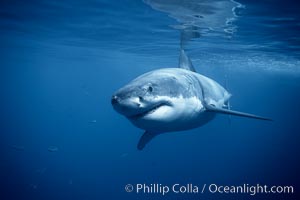
A great white shark swims underwater through the ocean at Guadalupe Island.
Species: Great white shark, Carcharodon carcharias
Location: Guadalupe Island (Isla Guadalupe), Baja California, Mexico
Image ID: 21346
Species: Great white shark, Carcharodon carcharias
Location: Guadalupe Island (Isla Guadalupe), Baja California, Mexico
Image ID: 21346
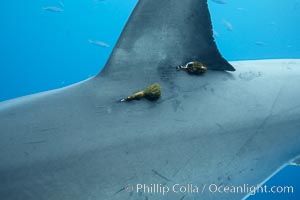
Two satellite tags, below dorsal fin of great white shark. The tags record the sharks movements, relaying data to researchers via satellite.
Species: Great white shark, Carcharodon carcharias
Location: Guadalupe Island (Isla Guadalupe), Baja California, Mexico
Image ID: 21391
Species: Great white shark, Carcharodon carcharias
Location: Guadalupe Island (Isla Guadalupe), Baja California, Mexico
Image ID: 21391
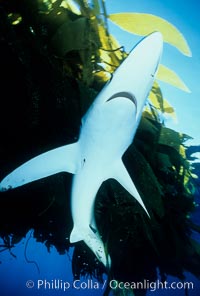
Blue shark searching drift kelp for food, open ocean.
Species: Blue shark, Prionace glauca
Location: San Diego, California
Image ID: 02288
Species: Blue shark, Prionace glauca
Location: San Diego, California
Image ID: 02288
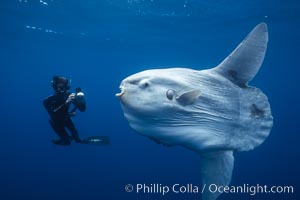
Ocean sunfish and freediving photographer, open ocean.
Species: Ocean sunfish, Mola mola
Location: San Diego, California
Image ID: 03325
Species: Ocean sunfish, Mola mola
Location: San Diego, California
Image ID: 03325
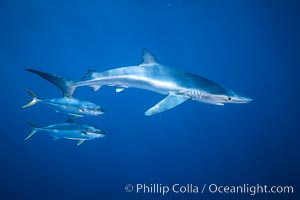
Blue shark and yellowtail in the open ocean.
Species: North pacific yellowtail, Yellowtail, Kingfish, Prionace glauca, Seriola lalandi
Location: San Diego, California
Image ID: 01000
Species: North pacific yellowtail, Yellowtail, Kingfish, Prionace glauca, Seriola lalandi
Location: San Diego, California
Image ID: 01000
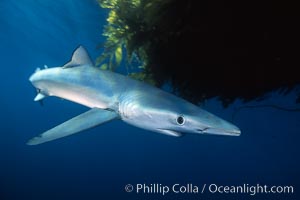
Blue shark and offshore drift kelp paddy, open ocean.
Species: Blue shark, Macrocystis pyrifera, Prionace glauca
Location: San Diego, California
Image ID: 01078
Species: Blue shark, Macrocystis pyrifera, Prionace glauca
Location: San Diego, California
Image ID: 01078
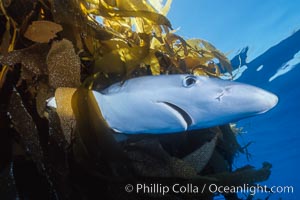
Blue shark and offshore drift kelp paddy, open ocean.
Species: Blue shark, Macrocystis pyrifera, Prionace glauca
Location: San Diego, California
Image ID: 01081
Species: Blue shark, Macrocystis pyrifera, Prionace glauca
Location: San Diego, California
Image ID: 01081
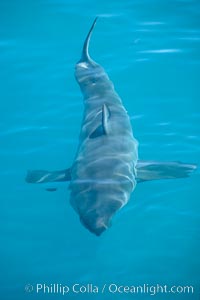
A great white shark swims just below the rippled ocean surface of Isla Guadalupe, far offshore of the Pacific Coast of Baja California.
Species: Great white shark, Carcharodon carcharias
Location: Guadalupe Island (Isla Guadalupe), Baja California, Mexico
Image ID: 07721
Species: Great white shark, Carcharodon carcharias
Location: Guadalupe Island (Isla Guadalupe), Baja California, Mexico
Image ID: 07721
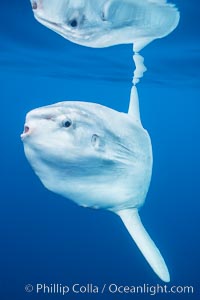
Ocean sunfish reflected on a glassy surface in bluewater, open ocean, southern California.
Species: Ocean sunfish, Mola mola
Location: San Diego, California
Image ID: 02413
Species: Ocean sunfish, Mola mola
Location: San Diego, California
Image ID: 02413
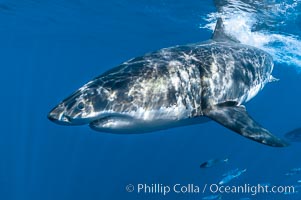
A great white shark swims through the clear waters of Isla Guadalupe, far offshore of the Pacific Coast of Baja California. Guadalupe Island is host to a concentration of large great white sharks, which visit the island to feed on pinnipeds and tuna.
Species: Great white shark, Carcharodon carcharias
Location: Guadalupe Island (Isla Guadalupe), Baja California, Mexico
Image ID: 07668
Species: Great white shark, Carcharodon carcharias
Location: Guadalupe Island (Isla Guadalupe), Baja California, Mexico
Image ID: 07668
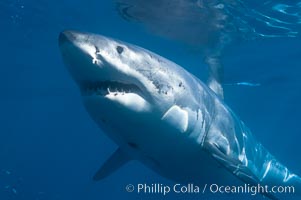
A great white shark swims through the clear waters of Isla Guadalupe, far offshore of the Pacific Coast of Baja California. Guadalupe Island is host to a concentration of large great white sharks, which visit the island to feed on pinnipeds and tuna.
Species: Great white shark, Carcharodon carcharias
Location: Guadalupe Island (Isla Guadalupe), Baja California, Mexico
Image ID: 07723
Species: Great white shark, Carcharodon carcharias
Location: Guadalupe Island (Isla Guadalupe), Baja California, Mexico
Image ID: 07723
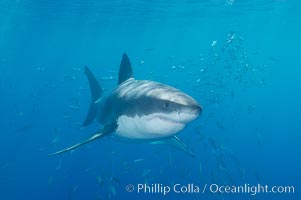
A great white shark underwater. A large great white shark cruises the clear oceanic waters of Guadalupe Island (Isla Guadalupe).
Species: Great white shark, Carcharodon carcharias
Location: Guadalupe Island (Isla Guadalupe), Baja California, Mexico
Image ID: 10110
Species: Great white shark, Carcharodon carcharias
Location: Guadalupe Island (Isla Guadalupe), Baja California, Mexico
Image ID: 10110
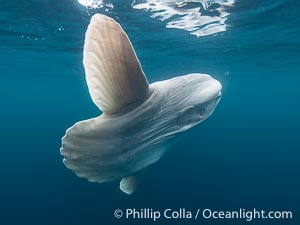
Dorsal and Caudal fins of the Ocean Sunfish Mola mola, as it Swims in the Open Ocean, near San Diego. The caudal fin is not a true tail but is a tail-like structure called a clavus that serves as a rudder. The dorsal (top) and anal (bottom) fins are used for propulsion.
Species: Ocean sunfish, Mola mola
Location: San Diego, California
Image ID: 39407
Species: Ocean sunfish, Mola mola
Location: San Diego, California
Image ID: 39407
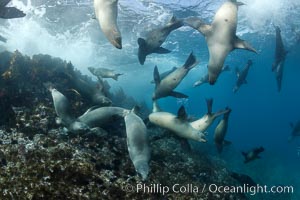
California sea lions, underwater at Santa Barbara Island. Santa Barbara Island, 38 miles off the coast of southern California, is part of the Channel Islands National Marine Sanctuary and Channel Islands National Park. It is home to a large population of sea lions.
Species: California sea lion, Zalophus californianus
Location: Santa Barbara Island, California
Image ID: 23429
Species: California sea lion, Zalophus californianus
Location: Santa Barbara Island, California
Image ID: 23429
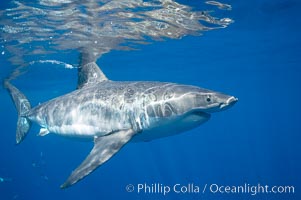
A great white shark swims through the clear waters of Isla Guadalupe, far offshore of the Pacific Coast of Mexico's Baja California. Guadalupe Island is host to a concentration of large great white sharks, which visit the island to feed on pinnipeds and use it as a staging area before journeying farther into the Pacific ocean.
Species: Great white shark, Carcharodon carcharias
Location: Guadalupe Island (Isla Guadalupe), Baja California, Mexico
Image ID: 19454
Species: Great white shark, Carcharodon carcharias
Location: Guadalupe Island (Isla Guadalupe), Baja California, Mexico
Image ID: 19454
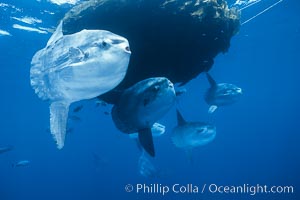
Ocean sunfish schooling near drift kelp, soliciting cleaner fishes, open ocean, Baja California.
Species: Ocean sunfish, Mola mola
Image ID: 06308
Species: Ocean sunfish, Mola mola
Image ID: 06308
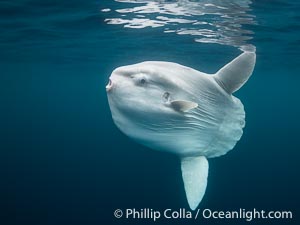
Ocean Sunfish swimming at the ocean surface in the Open Ocean.
Species: Ocean sunfish, Mola mola
Location: San Diego, California
Image ID: 39406
Species: Ocean sunfish, Mola mola
Location: San Diego, California
Image ID: 39406
